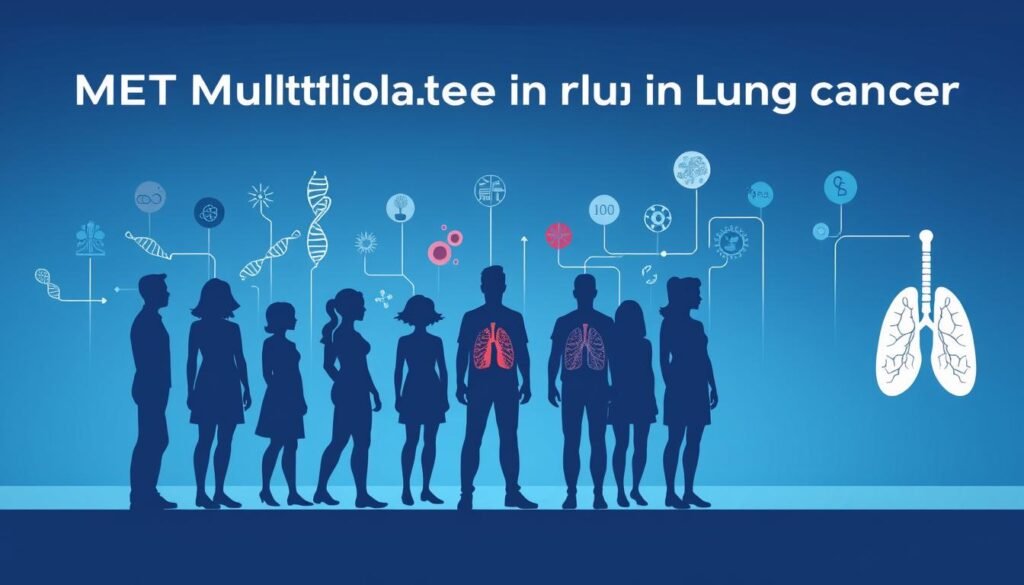About 5% of non-small cell lung cancers (NSCLCs) have MET gene changes. This fact is key for learning about MET mutations in lung cancer therapy. With precision oncology, markers like MET gene amplification and exon 14 skipping lead to personalized treatments. These treatments work better for the patient.
Knowing about these changes helps guide treatment choices and gives patients power. Exploring MET mutation lung cancer and the targeted therapies available brings hope. It can lead to better control and maybe a better quality of life. For more on MET testing, check out biomarker testing resources.
Key Takeaways
- Around 5% of NSCLCs are associated with MET gene alterations.
- Targeted therapy provides personalized treatment options for patients with MET mutations.
- Precision oncology focuses on using biomarkers to enhance treatment efficacy.
- Understanding MET mutations is essential for improving patient outcomes in lung cancer.
- Patients can explore treatment options and clinical trials for MET-related alterations.
Understanding MET Mutations in Lung Cancer
The MET gene is found on chromosome 7 and is important for cell processes like growth. When the MET gene changes, it can have big effects, especially on different lung cancers. Knowing about these changes helps create better treatments.
What is the MET Gene?
The MET gene makes a special protein that helps cells communicate. If it mutates, it can cause too much cell growth. This is common in lung adenocarcinoma. A study showed that about 25% of non-small cell lung cancers had higher MET levels than normal tissue.
Types of MET Biomarkers Relevant to Lung Cancer
For lung cancer, finding MET alterations is key. There are two main MET biomarkers for treatment:
- MET Gene Amplification: High MET gene levels have been seen in some kinds of lung adenocarcinoma samples. They’re higher than in other genes like EGFR and HGF.
- MET Exon 14 Skipping: This change affects the MET pathway in non-small cell lung cancer. Around half the cases have this mutation. Finding these mutations has been tough with some tests.
Identifying MET biomarkers is crucial. It lets doctors use specific drugs that improve survival and shape better treatments.
Who is Most Likely to Have MET Alterations?
Knowing who gets prevalence of MET alterations is key. It helps us find the right treatment for different lung cancers. MET changes are mostly seen in specific types of lung cancer. This shows why genetic tests are crucial for creating personalized treatment plans.
Prevalence of MET Alterations in Different Lung Cancer Types
About 3-4% of lung adenocarcinomas have MET mutations. These are common in non-small cell lung cancer. Also, 32% of pulmonary sarcomatoid carcinomas show MET exon 14 skipping mutations. In patients who haven’t received any treatment, we find MET mutations in about 2.6% of non-small cell lung cancer cases.
Finding these changes is very important. They can be key targets in treating met mutation lung cancer.
Demographic Factors Affecting MET Mutations
Certain factors affect the chance of having MET mutations in lung cancer patients. The average age of patients with MET exon 14 changes is about 73. Women and those who’ve never smoked tend to have these alterations more. On the other hand, younger patients, under 65 and with a history of smoking, often have MET amplifications.
Knowing these details helps tailor treatments to each patient’s needs. It’s vital for handling different kinds of lung cancer.

For more info on met mutation lung cancer and prevalence of MET alterations, check out Care Your Lungs. This site has lots of useful information.
Detecting MET Mutations in Lung Cancer
Finding MET mutations is key for tailoring lung cancer treatments. We have advanced methods like next-generation sequencing (NGS) and liquid biopsies. These techniques are crucial for accurate diagnosis and suitable treatment plans.
Next-Generation Sequencing (NGS)
NGS testing is a powerful tool for spotting MET mutations in lung cancer. It allows for the analysis of many genetic changes at once. This is done through tumor tissue samples.
Studies involving over 54,000 non-small cell lung cancer (NSCLC) patients utilized targeted NGS. It helped identify specific MET mutations in 138 patients. These findings support creating personalized treatments.
Biopsy vs. Liquid Biopsy
Traditional biopsies and liquid biopsies are both used to detect MET mutations. Biopsies take tissue samples from tumors but can be hard to do. Liquid biopsy, on the other hand, uses blood samples. It’s less invasive and more comfortable for patients.
This method is notable for its efficiency in identifying biomarkers. By using both biopsy types, doctors can more accurately find MET mutations. This leads to better treatment choices.

Combining NGS with liquid biopsy gives doctors a better way to find MET mutations. This approach improves prospects of selecting effective treatments for patients. For more info on the importance of MET mutation detection, click here.
MET Mutation Lung Cancer: Treatment Options
People with MET mutations in lung cancer get several treatment choices. MET inhibitors, like Capmatinib and tepotinib, have changed the game. These drugs are for those with MET exon 14 skipping mutations.
Targeted Therapy with MET Inhibitors
Using MET inhibitors for targeted therapy is promising. Approved by the FDA in 2020, Capmatinib showed success in the GEOMETRY Mono-1 trial. This drug is especially good for lung cancer with MET exon 14 skipping mutations, found in 3-4% of cases. About 32% responded to crizotinib, with a median of 7.3 months till the cancer progressed again.
Chemotherapy and Immunotherapy Options
Chemotherapy and immunotherapy are also key. For MET amplification, crizotinib’s results differed based on the amplification level. High MET amplification saw up to 6.7 months before cancer progressed. Side effects like swelling and stomach issues were common. Using chemo and immunotherapy together can help, especially if MET inhibitors aren’t enough on their own.
| Treatment Option | Response Rate | Median PFS | Adverse Events |
|---|---|---|---|
| Capmatinib | Varies based on mutation | Pending more studies | Monitor for side effects |
| Crizotinib (for MET exon 14) | 32% | 7.3 months | Peripheral edema, fatigue |
| Crizotinib (for MET amplification) | 27% | 6.7 months (high MET amplification) | Gastrointestinal symptoms |
A team approach that uses targeted therapy, chemotherapy, and immunotherapy is best. This way, doctors can create the right treatment plan for those with MET mutations.
First-Line Treatment for MET Alterations
Finding the right first-line treatment is key for patients with MET exon 14 skipping mutations. New targeted therapies provide treatments that match their genetic makeup. This ensures patients get the most effective care.
Standard Treatments for MET Exon 14 Skipping
The main treatments for MET exon 14 skipping are certain tyrosine kinase inhibitors (TKIs). These TKIs are crucial as they target the genetic mutations found in some lung cancers. Capmatinib and tepotinib are the two top drugs used.
Role of Capmatinib and Tepotinib
Capmatinib is a top option for patients with these mutations, approved by the FDA in May 2020. It’s taken by mouth, twice a day, at 400 mg. Tepotinib is another MET TKI that works well against this mutation. The creation of these drugs shows how treatment has evolved. Now, knowing about MET alterations can help choose the right therapy.

Research is still looking at how best to use these drugs in treatment plans. As research continues, treatments are getting better and smarter. The introduction of capmatinib and tepotinib is changing how doctors treat patients with MET alterations.
| Medication | Type | FDA Approval | Dosage |
|---|---|---|---|
| Capmatinib | Type I TKI | May 2020 | 400 mg orally twice daily |
| Tepotinib | Type I TKI | Approved | Varies based on protocol |
Clinical Trials for MET Mutation Lung Cancer
Clinical trials are key in making progress against lung cancer, especially for those with MET mutations. They constantly seek new treatments to bring hope to patients with few choices. Right now, many promising MET inhibitors are being tested. They could change how we treat lung cancer.
Emerging Treatments in Research
Here’s a look at what’s being tested in clinical trials for MET mutation lung cancer:
- Capmatinib and Tepotinib, both FDA-approved for MET exon 14-skipping mutations.
- Crizotinib, which had an objective response rate (ORR) of 44% according to the PROFILE 1001 study.
- Savolitinib, showing an ORR of 49.2% in patients with MET mutations.
- Amivantamab, a bispecific antibody that targets EGFR and MET, with a 33% response rate in relevant patients.
- APL-101, a selective c-MET inhibitor being studied in a Phase I/II trial.
Criteria for Participation in Clinical Trials
To join clinical trials, there are necessary criteria to be met:
- Your lung cancer type, particularly if you have MET exon 14-skipping mutations.
- Your past treatments and how well they worked.
- Genetic markers that may affect how well treatments will work for you.
- Your overall health and if you can handle the treatments studied.
Understanding these criteria and new treatments from clinical trials offers patients new therapy options. This can greatly improve their chances in fighting lung cancer.
Managing Side Effects of MET Inhibitors
Taking MET inhibitors is good for patients with a certain type of lung cancer. But, side effects are a big concern for them. These side effects, like swelling in the body, are tough. Despite these issues, it’s key to manage them for a better life during treatment.
Common Side Effects of Targeted Therapy
Nausea and throwing up are common with MET inhibitors. These symptoms can greatly disrupt daily life. Also, a lot of patients see swelling from fluid buildup. This swelling is often hard to treat with usual water pills.
Strategies for Managing Adverse Effects
To handle side effects, a detailed plan is needed. Strategies include:
- Proactive monitoring: Getting checked regularly helps catch and fix problems early.
- Compression stockings: These help with the swelling.
- Dietary adjustments: Eating less salt can reduce the swelling.
- Dose adjustments: Changing how much medicine you take can ease side effects.
Learning about side effects is crucial. Patients need to know what might happen to work well with doctors. Reading resources like this informative article can be very helpful. It’s important for patients to know that swelling and nausea are common and to be ready for them.
Engaging with Precision Oncology
Precision oncology is changing lung cancer treatment. It focuses on tailored therapies. These therapies are based on a person’s unique genetic makeup and MET mutations. Health care teams use genetic tests to find the best treatment. This makes sure patients get therapies suited to their specific cancer traits.
The Role of Personalized Medicine in Treatment
Personalized medicine is important for improving lung cancer treatment. Thanks to new research, about 60-70% of lung adenocarcinomas have changes that can be targeted with treatment. Precision oncology makes these treatments possible. It greatly enhances survival rates and life quality for those fighting lung cancer.
Communicating with Healthcare Providers for Best Outcomes
Talking to healthcare providers is essential when exploring treatment routes. Patients can learn about their options, clinical trials, and tests. This open dialogue makes sure patients are involved in planning their treatment. Getting a second opinion is also a good idea. It helps patients find the most fitting treatment for their lung cancer.
| Cancer Type | Potentially Actionable Alterations (%) | Targeted Therapy Options |
|---|---|---|
| Lung Adenocarcinoma | 60-70% | EGFR Inhibitors, ALK Inhibitors |
| Squamous Cell Carcinoma | Varies | Clinical Trials Under Investigation |
| Small Cell Lung Carcinoma | Still Under Investigation | Emerging Therapies |
Conclusion
Understanding MET mutation lung cancer is key to creating better treatments. Recent studies show that targeted therapy is a new hope for those with specific MET changes. With 3–5% of non-small cell lung cancer cases, especially in adenocarcinoma and its sarcomatoid type, spotting these mutations is vital.
Precision oncology means treatments are tailored to each patient, improving chances of success. Patients with MET exon 14 changes have new options like Capmatinib, Tepotinib, and Savolitinib. These treatments have had good results in tests. With treatments always changing, it’s important to talk to doctors about the latest options for your unique genetic make-up.
In short, treating MET mutation lung cancer shows why personalized care is so important in oncology. By understanding their condition and talking to their doctors, patients can find the most effective treatments. This ensures they have the best possible care for their specific situation.